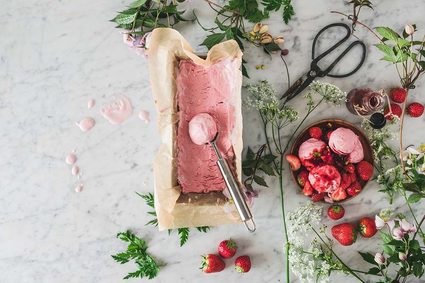Perfect Ice Cream Calculator
If you need an excuse to cool down with a few scoops of a refreshing frozen dessert — here it is! The 18th of July is approaching, meaning that we're going to celebrate National Ice Cream Day 🍦 in the United States. It may not seem unique considering that , but you can make it special by designing and testing your own recipes!
This idea can be even more appealing now — not only is July the hottest month, but also . Preparing your sweet treats can save you the hassle of going shopping as often to resupply.
Don't worry if you've never done that before. We've created this ice cream calculator to help you make your ice cream as delicious as your favorites (if not more)! It estimates how soft, sweet, and caloric it's going to be, so you can tweak the recipe beforehand instead of doing it by trial and error. Read on to find tips on how to keep it diet-friendly yet tasty.

We all scream for ice cream — frozen desserts that stole American hearts
You may wonder why National Ice Cream Day is a thing in the first place. Does ice cream originate from the U.S.? Not really — the earliest reference to ice cream in North America comes from 1744, whereas similar frozen desserts existed even before Christ.
What's there to celebrate, then? It turns out that the Founding Fathers loved ice cream — . The nation followed and actually revolutionized the entire industry. Previously, frozen desserts were accessible only to the creme of society, but Nancy Johnson's invention simplified the making process and made icy treats accessible for everyone.
A few years later, the ice cream soda was born. It turned out to be such a hit that millions of people would go to soda fountains to enjoy icy treats.
Ice cream also played a role in upkeeping morale during World War II. The military became one of the major producents, and they even built the first "floating ice cream parlor" for sailors. Since the product rationing ended with the war, the victory was celebrated, obviously, with ice cream.

Finally, in 1984, President Ronald Reagan designated the third Sunday of July as National Ice Cream Day, which is why we celebrate!
No more my way or the highway — make your perfect ice cream!
Have you ever been frustrated because your favorite ice cream was out of stock? Or perhaps no brand can satisfy your tastebuds at all? Well then, it's time to learn how to make frozen desserts at home so you can have them however and whenever you please.
While a dedicated machine reduces the process to chucking the ingredients inside and letting it do the work, all you really need is a working freezer. What about the ? We can split them into two categories:
- Mandatory:
-
Cream — Its high fat content is responsible for the rich flavor and soft texture as it coats the ice crystals. The cream also traps the air, which results in producing ice cream that's light and not as cold as a regular chunk of ice.
-
Milk — Due to its high water content, it puts the ice in ice cream. It also contains proteins and lactose that help trap air during the churning and control the crystal size. You can use sweetened condensed milk instead and skip the sugar.
-
Sweetener that contains no water — It means that sugar syrup, honey, dextrose won't do. Its role is not only making your ice cream sweet but also soft by lowering its freezing point depression. Otherwise, it'd be hard to scoop!
-
- Optional:
-
Flavorings — It's hard to omit them if you're going for a specific taste!
-
Stabilizers — They are either proteins or carbohydrates that increase viscosity (to thicken water; visit the water viscosity calculator to understand the physics of it!), slow down melting, and give the milk a hand in reducing the crystal growth. An example could be a xanthan gum that's also commonly used in milkshakes.
-
Emulsifiers — Their role is to help mix water and fat to obtain the perfect ice cream mixture, resulting in an even smoother final dessert. Don't get discouraged by the name — you don't need any sophisticated chemicals; an egg will do.
-
Some recipes may also ask for extras like butter or water. They enhance the consistency and texture, so we recommend adding them if possible!
Alright, we have the ingredients; what now? There's a , with the best ones being:
-
Freeze and stir — After preparing the base, pour it into the bowl and put it inside the freezer. Stir the mixture vigorously every 30 to 45 minutes over 4 hours. Et voilà, it's done!
-
Ice bath — Put lots of ice and some salt into a huge container and nest a smaller bowl inside — this is where the ice cream mix goes. Mix it for 10 — 15 minutes, then place the entire set-up inside the freezer for 45 minutes. Stir it again for 5 minutes, and freeze only the small bowl for 2 hours or longer.
-
Food processor — Pour the mixture inside a bag, seal it tightly and allow it to freeze completely. Then, use the food processor to make it completely smooth, scrape it into a container, and place it back into the freezer.
How to use the ice cream calculator to sweeten up your life just right?
You've got the recipe and the method you're going to use. Isn't that all you need? Why would you want to calculate the sweetness and softness? There are various reasons:
-
If you want to tweak the recipe, for example, by replacing or adding some ingredients without affecting the final product.
-
Everyone's tastebuds are different. With our calculator, you can check how sweet the original mix is and adjust it accordingly.
-
Some people prefer their desserts icier, whereas others like them creamy. If you can predict the texture, it's more likely the ice cream will turn out just right!
Alright, you're convinced. The question arises: how to use the calculator? 🤔
Our goal was to make it as intuitive as possible. There are seven categories of ingredients: milk, cream, sweetener, flavoring, emulsifier, stabilizer, and additional ingredients. Each has a list with plenty of options, so choose whatever you're going to use in your mix and its quantity. As soon as you start filling in the first two fields, the calculator will tell you how sweet and soft your ice cream will likely be and give you some suggestions on how to make it even more delicious.
You'll also learn how much of the sweet treat you will obtain, the percentage of solids, fats, and sugar, as well as the calorie content per 100 grams.
Does it fit my macros? Make your ice cream lighter and healthier
If you're concerned by the number of calories per serving, don't give up on celebrating just yet! Whether you religiously follow the results from the if it fits your macros calculator or simply want to avoid additional calories to burn, we've got you covered. Low-kcal ice cream tends to be more expensive, but you can make it yourself by making a few changes to your usual recipe:
-
Go for skimmed milk instead of cream. If you're vegan, opt for unsweetened dairy alternatives like almond, coconut, or soy. Our recommendations are lower in fat and, therefore, less caloric.
-
Consider adding milk or whey protein to improve the nutritional values. Proteins also keep you satiated for longer, so you're less likely to "make up" for the saved calories later.
-
Replace sugar with a sweetener. Popular manufacturers tend to use erythritol, sometimes mixed with stevia.
-
Look for flavoring alternatives. If you fancy chocolate ice cream, use low-fat cocoa powder instead of a regular one.
Of course, you can always reduce the amount of, e.g., cream and add some milk instead of completely getting rid of it — it'll still be an improvement!
Unusual flavors you might want to try
If we ran a popularity contest of ice cream flavors in the United States, the podium would be occupied by chocolate, vanilla, and strawberry tied with butter pecan. This makes them widely available and, therefore, quite dull for some people (although still delicious!). Luckily, making ice cream at home is the perfect opportunity to try something out of the ordinary.
For those of you seeking inspiration, we've found some unique flavors that might be worth trying:
-
Cream cheese 🍰 — One of the most beloved frostings now as an icy dessert. It's said to taste a bit like a cheesecake. Yum!
-
Guinness 🍺 — You've read that right. If you're a fan of Irish stouts (and of drinking age), this one may be just for you. You might as well play some beer pong in the garden or by the pool, too.
-
Pumpkin 🎃 — Are you counting down until Halloween already or simply keen on the winter squash? We've got good news — if you manage to lay your hands on some pumpkin puree, you can make it feel like autumn for a while!
-
London fog ☕ — Some people love tea with milk, while others can't understand this phenomenon. Which side will you be on when it comes to ice cream that tastes like Earl Grey with vanilla? Also, make sure to check the tea brewing calculator to improve your experience!
-
Bread 🍞 — We, too, wanted to discard it as a ridiculous idea, but apparently, the taste is comparable to vanilla custard with a somewhat caramel-y aroma thanks to the breadcrumbs. This way, you can include more whole grains in your diet, too!
These are our suggestions, but naturally, there are plenty of other flavors worth giving them a shot.
Heat ease without the brain freeze
Have you ever taken a gulp of a chilled drink or a mouthful of ice cream just to feel an immediate headache? If you answered "yes", then you're among millions of people who have experienced the brain freeze, with a cute medical name sphenopalatine ganglion neuralgia. Although it goes as rapidly as it comes, we'd probably like to avoid experiencing it at all. Good news — we can. Since it's a survival reflex responding to the temperature drop inside your mouth, you should be able to prevent it by taking smaller bites (or sips) and slowing down.
What if it's already happened? Ideally, remove the cold substance from your mouth and warm up the roof by pressing your tongue or thumb or drinking something tepid.
Hopefully, now you know not only how to make your own ice cream but also how to enjoy it safely!